The Australian Energy Regulator (AER) published SA Power Networks’ (SAPN’s) approved 2015-16 pricing proposal on 30 June 2015. This proposal contains the network tariffs that will apply in South Australia for the 2015-16 financial year. A copy of the full proposal can be viewed on the AER’s website here.
Small business customers in South Australia can expect some reductions in energy costs from July 2015, at least with respect to their regulated network charges. Using the example of a 10,000 kWh per year small business customer connection on a single rate network tariff, network savings of around 17% can be expected compared to 2014-15 rates. This should amount to a reduction on the total electricity bill of around 9% that is attributable to these reduced network charges.
More significant changes are in store for medium to large business electricity customers in South Australia from July 2015.
SAPN is continuing the process of reform that will ultimately have all customers on cost-reflective network tariffs. This is being achieved by transitioning customers from historic tariffs, some of which were based largely on energy usage (kWh), to network capacity utilisation or demand-based (kVA) tariffs.
There are a range of tariff types that apply to medium to large business, some levied on the basis of negotiated or “agreed” annual demand and others levied on the basis of actual peak and shoulder demand on a monthly (or billing period) and seasonal basis.
SAPN has also introduced some transitional tariffs to accommodate customers who would otherwise be worse off by being transferred to one of the new demand-based tariffs.
SAPN currently has approximately 5,500 large business customers in SA consuming more than 160 MWh (160,000 kWh) of electricity per year. Around 80% of these customers or ~4,500 are currently on cost-reflective demand tariffs. The remaining 1,000 are being assigned to cost-reflective tariffs in July 2015. Some will be transferred to transition tariffs to dampen the impact of the move to cost-reflectively over a period of up to 5 years to June 2020.
Customers on transition tariffs also need to be aware that certain actions post 1 July 2015 may trigger an automatic transfer from a transition tariff to a cost-reflective demand tariff, including (among other things):
• Relocating a meter that involves an SAPN site visit to de-energise/re-energise supply;
• Installing solar PV;
• Installing battery storage;
• Meter isolator installation.
SAPN will be notifying affected customers of the 2015-16 network tariff changes by letter. Click here for examples of the specific impact of these tariff changes on SA businesses.
Customers who:
• are uncertain of the impact of the network tariff changes on their business; or
• would like to confirm that they are, or have been placed on the lowest cost network tariff by SAPN; or
• would like to optimise their network tariff selection based on their historic and forecast electricity usage,
can contact e4b on 1800 781 791 or email us.
Given this significant move for many customers from usage to demand-based tariffs, it is also timely to consider the additional costs associated with a poor power factor in your business. Customers with a poor power factor should assess the merits of installing a power factor correction (PFC) system to further reduce electricity costs. Depending upon the energy usage and demand characteristics of the site the payback on PFC systems can be as short as 12 months.
Click here for further information on power factor and power factor correction.
For advice on the impact of these changes and options for reducing your energy spend, contact e4b on 1800 781 791 or email us.


